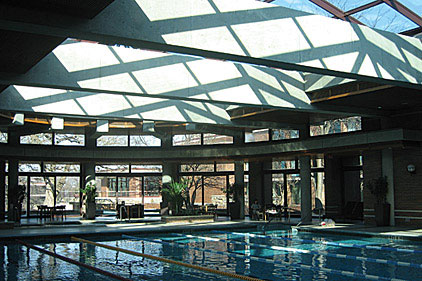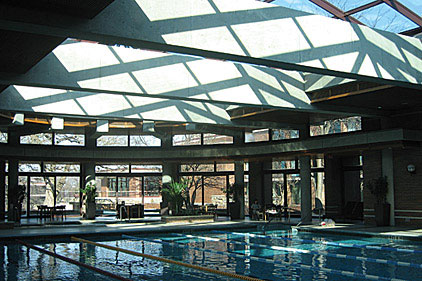
|
| McDonald’s Hamburger University, which teaches and houses McDonald’s staff, was in need of a new dehumidification system for its pool facility. The new system was able to prevent window condensation and protect wood-laminate slats in the pool area. |
HU resides on McDonald’s corporate campus in Oak Brook, IL, along with the Hyatt Lodge. The lodge building was originally used as a dormitory and teaching area for students and was managed by McDonald’s. After 10 years, McDonald’s shifted daily operations to the Hyatt while still retaining ownership of the building. The 218-room lodge now serves HU students, corporate employees, and suppliers on a daily basis.
The lodge also includes a large pool facility with a heated 70-ft indoor lap pool for water sports, three whirlpools, a sauna, and a steam room. The indoor pool and whirlpools are supported by a dehumidification system that manages the space conditions.
The Hyatt wanted to ensure that the pool facility maintained ideal temperature and humidity conditions while remaining free of condensate. The pool is surrounded by a number of windows that provide natural light, but they are also a prime location for condensate formation.
Additionally, the entire ceiling is covered with finished wood laminated slats that hide the mechanical ventilation system. Excessive moisture formation on the wood would lead to discoloration and eventual rotting.
After nearly 20 years of operation, McDonald’s determined that the system needed to be replaced. However, the large dehumidifier was originally installed in the second floor mechanical room of a three-story building without proper attention to how it would be replaced when it reached the end of its usable life.
Jon Books, sales engineer for Westside Mechanical in Naperville, IL, immediately became part of the discussion on how to proceed.
“Westside Mechanical has been servicing the current PoolPak dehumidifier since the early nineties and we know the system and the application very well,” said Books. “There is absolutely no way to raze the walls or roof to remove the old and install the new unit because the mechanical room is buried deeply within the building.”
Adding to the challenge, the Hyatt mechanical room was only accessible via a long narrow hallway that was not only occupied by food and equipment, but also served as a thoroughfare for Hyatt’s wait staff. Food service could not be interrupted for any reason since the Lodge was booked at all times.
The only practical solution for the system change-out was to build the new unit on-site, and Westside Mechanical looked to PoolPak International for the replacement system. In preparing to ship the unit, PoolPak assembles all the component parts for shipping as they would if they had built it at the factory. The only preassembled components are the wiring harnesses, the electrical control board, and certain areas of the refrigeration pack. At the jobsite, all the parts such as rails, sheet metal, and motors are staged for easy access.
The replacement model is a PoolPak SWHP 190SR with a 40-ton capacity capable of removing 215 lbs. of moisture per hour at 82°F and 50% relative humidity. It was fitted with high efficiency Backward Inclined Airfoil-Type Fans and high efficiency motors. Also included was a VFD booster pump that supplied the PoolPak’s pool water condenser with pool water. A GPM gauge constantly monitors water flow to ensure exact water feed to the unit at all times and under all conditions.
A window of two weeks was given to complete the job; one for removal of the old system and the second for installation of the new unit. PoolPak sent five of their manufacturing technicians to the jobsite along with four HVAC technicians from Westside Mechanical.
During the building of the unit, the men worked in small groups on a predetermined schedule to keep supplying parts to the assembly people. PoolPak technicians were responsible for all brazing on the refrigeration system to ensure leak-proof operation. The installation was completed on time, and Westside, with 9 factory-trained technicians on staff, commissioned the unit right on schedule.
Rico Morelli, an engineer and mechanic for the facility, said the new system resulted in a significant improvement for the facility.
“The larger fans on the new unit increased the performance of the system, which improved the overall air quality,” said Morelli.
The spec also called for a CO2 demand ventilation system that lowers outside air below the ASHRAE standard when the space CO2 level is lower than the target amount. By reducing the quantity of outside air, “you save significantly on heating and cooling costs,” Morelli said.
Books said that follow-up with McDonald’s pool maintenance personnel have confirmed that the unit operates more quietly and responds faster to changing pool conditions.


